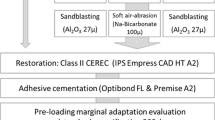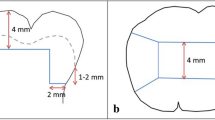Abstract
The present study evaluated the influence of different composite bases and surface treatments on marginal and internal adaptation of class II indirect composite restorations, after simulated occlusal loading. Thirty-two class II inlay cavities were prepared on human third molars, with margins located in cementum. A 1-mm composite base extending up to the cervical margins was applied on all dentin surfaces in the experimental groups; impressions were made and composite inlays fabricated. The following experimental conditions were tested: no liner (control group), flowable composite treated with soft air abrasion (experiment 1), flowable composite sandblasted (experiment 2) and restorative composite sandblasted (experiment 3). All specimens were submitted to 1,000,000 cycles with a 100-N eccentric load. Tooth–restoration margins were analysed semi-quantitatively by scanning electron microscopy before and after loading; internal adaptation was also evaluated after test completion. The percentage of perfect adaptation in enamel was 79.5% to 92.7% before loading and 73.3% to 81.9% after loading. Perfect adaptation to dentin was reduced before loading (54.8% to 77.6%) and after loading (41.9% to 63%), but no difference was found among groups for pre- and post-loading conditions. No debonding occurred between the base and composite luting. A significant, negative influence of cyclic loading was observed. The results of the present study support the use of flowable or restorative composites as base/liner underneath large class II restorations. Soft air abrasion represents a potential alternative to airborne particle abrasion for treating cavities before cementation. The application of a composite base underneath indirect composite restorations represents a feasible non-invasive alternative to surgical crown lengthening to relocate cavity margins from an intra-crevicular to supra-gingival position.







Similar content being viewed by others
References
Lutz F, Kull M (1980) The development of a posterior tooth composite system, in vitro investigation. SSO Schweiz Monatsschr Zahnheilkd 90:455–483
Lutz F, Krejci I, Luescher B, Oldenburg TR (1986) Improved proximal margin adaptation of class II composite resin restorations by use of light-reflecting wedges. Quintessence Int 17:659–664
Lutz E, Krejci I, Oldenburg TR (1986) Elimination of polymerization stresses at the margins of posterior composite resin restorations: a new restorative technique. Quintessence Int 17:777–784
Weaver WS, Blank LW, Pelleu GB Jr (1988) A visible-light-activated resin cured through tooth structure. Gen Dent 36:236–237
Bertolotti R (1991) Posterior composite technique utilizing directed polymerization shrinkage and a novel matrix. Pract Periodontics Aesthet Dent 3:53–58
Donly KJ, Wild TW, Bowen RL, Jensen ME (1989) An in vitro investigation of the effects of glass inserts on the effective composite resin polymerization shrinkage. J Dent Res 68:1234–1237
Friedl KH, Schmalz G, Hiller KA, Mortazavi F (1997) Marginal adaptation of composite restorations versus hybrid ionomer/composite sandwich restorations. Oper Dent 22:21–29
Bowen RL, Nemoto K, Rapson JE (1983) Adhesive bonding of various materials to hard tooth tissues: forces developing in composite materials during hardening. J Am Dent Assoc 106:475–477
Davidson CL, de Gee AJ, Feilzer A (1984) The competition between the composite–dentin bond strength and the polymerization contraction stress. J Dent Res 63:1396–1399
de Gee AF, Feilzer AJ, Davidson CL (1993) True linear polymerization shrinkage of unfilled resins and composites determined with a linometer. Dent Mater 9:11–14
Kildal KK, Ruyter IE (1997) How different curing methods affect mechanical properties of composites for inlays when tested in dry and wet conditions. Eur J Oral Sci 105:353–361
Dietschi D, Spreafico R (1997) Adhesive metal free restorations: current concepts for the aesthetic treatment of posterior teeth. Quintessence, Berlin, pp 60–77
Dietschi D, Spreafico R (1998) Current clinical concepts for adhesive cementation of tooth-colored posterior restorations. Pract Periodontics Aesthet Dent 10:47–54
Rocca GT, Krejci I (2007) Bonded indirect restorations for posterior teeth: from cavity preparation to provisionalization. Quintessence Int 38:371–379
Kemp-Scholte CM, Davidson CL (1990) Marginal integrity related to bond strength and strain capacity of composite resin restorative systems. J Prosthet Dent 64:658–664
Kemp-Scholte CM, Davidson CL (1990) Complete marginal seal of class V resin composite restorations effected by increased flexibility. J Dent Res 69:1240–1243
Ausiello P, Rengo S, Davidson CL, Watts DC (2004) Stress distributions in adhesively cemented ceramic and resin–composite class II inlay restorations: a 3D-FEA study. Dent Mater 20:862–872
Scott JA, Strang R, Saunders WP (1992) The plane of fracture and shear bond strength of three composite inlay systems. Dent Mater 8:208–210
Krejci I, Fullemann J, Lutz F (1994) Clinical and long-term scanning electron microscopic studies of composite inlays. Schweiz Monatsschr Zahnmed 104:1351–1356
Magne P, Knezevic A (2009) Thickness of CAD-CAM composite resin overlays influences fatigue resistance of endodontically treated premolars. Dent Mater 25:1264–1268
Rodrigues SA Jr, Ferracane JL, Della Bona A (2009) Influence of surface treatments on the bond strength of repaired resin composite restorative materials. Dent Mater 25:442–451
Ciucchi B, Bouillaguet S, Holz J, Pashley D (1995) Dentinal fluid dynamics in human teeth, in vivo. J Endod 21:191–194
Krejci I, Reich T, Lutz F, Albertoni M (1990) An in vitro test procedure for evaluating dental restoration systems. 1. A computer-controlled mastication simulator. Schweiz Monatsschr Zahnmed 100:953–960
Krejci I, Heinzmann JL, Lutz F (1990) The wear on enamel, amalgam and their enamel antagonists in a computer-controlled mastication simulator. Schweiz Monatsschr Zahnmed 100:1285–1291
Luescher B, Lutz F, Ochsenbein H, Muhlemann HR (1977) Microleakage and marginal adaptation in conventional and adhesive class II restoration. J Prosthet Dent 37:300–309
Roulet J (1990) Degradation of dental polymers. Karger, Basel, pp 108–10
Ausiello P, Apicella A, Davidson CL (2002) Effect of adhesive layer properties on stress distribution in composite restorations—a 3D finite element analysis. Dent Mater 18:295–303
Dietschi D, Olsburgh S, Krejci I, Davidson C (2003) In vitro evaluation of marginal and internal adaptation after occlusal stressing of indirect class II composite restorations with different resinous bases. Eur J Oral Sci 111:73–80
Chuang SF, Jin YT, Liu JK, Chang CH, Shieh DB (2004) Influence of flowable composite lining thickness on class II composite restorations. Oper Dent 29:301–308
Dewaele M, Asmussen E, Devaux J, Leloup G (2006) Class II restorations: influence of a liner with rubbery qualities on the occurrence and size of cervical gaps. Eur J Oral Sci 114:535–541
Brannstrom M (1966) The hydrodynamics of the dental tubule and pulp fluid: its significance in relation to dentinal sensitivity. Annu Meet Am Inst Oral Biol 23:219
Paul SJ, Scharer P (1997) The dual bonding technique: a modified method to improve adhesive luting procedures. Int J Periodontics Restorative Dent 17:536–545
Bertschinger C, Paul SJ, Luthy H, Scharer P (1996) Dual application of dentin bonding agents: effect on bond strength. Am J Dent 9:115–119
Dietschi D, Herzfeld D (1998) In vitro evaluation of marginal and internal adaptation of class II resin composite restorations after thermal and occlusal stressing. Eur J Oral Sci 106:1033–1042
Magne P, Douglas WH (1999) Porcelain veneers: dentin bonding optimization and biomimetic recovery of the crown. Int J Prosthodont 12:111–121
Magne P, So WS, Cascione D (2007) Immediate dentin sealing supports delayed restoration placement. J Prosthet Dent 98:166–174
Wiegand A, Buchalla W, Attin T (2007) Review on fluoride-releasing restorative materials—fluoride release and uptake characteristics, antibacterial activity and influence on caries formation. Dent Mater 23:343–362
Stavridakis MM, Krejci I, Magne P (2005) Immediate dentin sealing of onlay preparations: thickness of pre-cured dentin bonding agent and effect of surface cleaning. Oper Dent 30:747–757
Rocca GT, Krejci I (2007) Bonded indirect restorations for posterior teeth: the luting appointment. Quintessence Int 38:543–553
Dietschi D (2003) Evaluation of marginal and internal adaptation of adhesive class II restorations. Dissertation, ACTA University of Amsterdam
Bouillaguet S, Ciucchi B, Jacoby T, Wataha JC, Pashley D (2001) Bonding characteristics to dentin walls of class II cavities, in vitro. Dent Mater 17:316–321
Purk JH, Dusevich V, Glaros A, Eick JD (2007) Adhesive analysis of voids in class II composite resin restorations at the axial and gingival cavity walls restored under in vivo versus in vitro conditions. Dent Mater 23:871–877
Rees JS, Jacobsen PH, Hickman J (1994) The elastic modulus of dentine determined by static and dynamic methods. Clin Mater 17:11–15
Kinney JH, Balooch M, Marshall SJ, Marshall GW Jr, Weihs TP (1996) Hardness and Young's modulus of human peritubular and intertubular dentine. Arch Oral Biol 41:9–13
Kinney JH, Balooch M, Marshall GW, Marshall SJ (1999) A micromechanics model of the elastic properties of human dentine. Arch Oral Biol 44:813–822
Conflict of interest
Authors declare that they have no financial, professional or other personal interest that could influence the position presented in this paper.
Author information
Authors and Affiliations
Corresponding author
Rights and permissions
About this article
Cite this article
Rocca, G.T., Gregor, L., Sandoval, M.J. et al. In vitro evaluation of marginal and internal adaptation after occlusal stressing of indirect class II composite restorations with different resinous bases and interface treatments. “Post-fatigue adaptation of indirect composite restorations”. Clin Oral Invest 16, 1385–1393 (2012). https://doi.org/10.1007/s00784-011-0632-x
Received:
Accepted:
Published:
Issue Date:
DOI: https://doi.org/10.1007/s00784-011-0632-x




